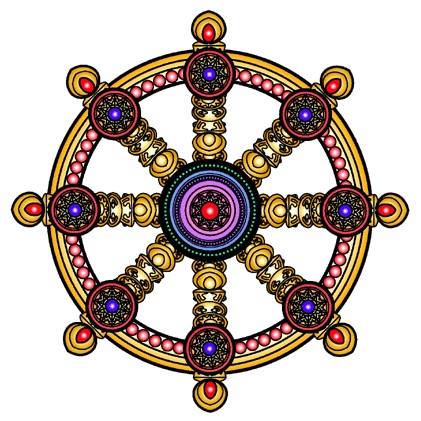 This school of Buddhism is known as Jodo Shinshu or Shin Buddhism, founded by Shinran (1173-1262) in Japan, consisting of ten branches. This particular one is formally called Shinshu Otani-ha, and commonly regarded as Higashi Honganji. Its foundation is based on three sutras (recorded sermons of Shakyamuni Buddha), the Larger Sutra, the Smaller Sutra, and the Meditation Sutra, the main teachings of what is called Pure Land Buddhism.
This school of Buddhism is known as Jodo Shinshu or Shin Buddhism, founded by Shinran (1173-1262) in Japan, consisting of ten branches. This particular one is formally called Shinshu Otani-ha, and commonly regarded as Higashi Honganji. Its foundation is based on three sutras (recorded sermons of Shakyamuni Buddha), the Larger Sutra, the Smaller Sutra, and the Meditation Sutra, the main teachings of what is called Pure Land Buddhism.
The Pure Land tradition evolved in China, but did not become a separate denomination until the 12th century in Japan with the appearance of Honen (1133-1212), Shinran's teacher. Honen was a monk at the Tendai monastery on Mt. Hiei near Kyoto. Being dissatisfied with the traditional monastic path of trying to reach enlightenment through ascetic practices, which made Buddhism inaccessible to most people, Honen chose the teaching of the Nenbutsu, the recitation of Namu Amida Butsu (I take refuge in Amida Buddha). Therefore, he left Mt. Hiei to share the teaching with those incapable to self-powered practices.
Shinran shared a similar path. He entered monastic life at the age of nine, then spent twenty years, studying the Tendai teachings. The experience, though, left him empty and feeling faraway from the awakening the Buddha had described. He departed from Mt. Hiei in 1201, and joined a group already established by Honen. In him, Shinran saw a totally different model of a Buddhist teacher, one who considered himself first and foremost a fellow student, a person who exhibited total humility in all aspects of his life.

(Honen and Shinran at Yoshimizu, Kyoto)
Through Honen and the teaching of Nenbutsu. Shinran discovered a totally different path of Buddhism. He wrestled with the fact that the gaining of knowledge and practice during the previous two decades had not made him a better person. In fact, that experience had left him more arrogant, feeling superior to those who had studied and practiced less than he had done. Therefore, as a result, Shinran felt further from the awakening he saw in the model of Shakyamuni Buddha. In Honen and in the teaching of Nenbutsu, he realized that Buddhism was truly universal, and open to anyone who could come to an honest evaluation of themselves as a person being controlled by their own ego. He considered himself a bombu, a person clouded by ignorance and filled with self-contentedness. In Namu Amida Butsu, he saw the vehicle that could enable him to realize the truth about himself. Pure Land Buddhism has been incorrectly described as a theistic version of Buddhism, with Amida Buddha in the role of a god leading everyone to salvation, expressed as birth in the Pure Land. Shinran's understanding, however, was that Amida was not a mythical Buddha who promised salvation to anyone who repeated his name, but rather, a symbol of the Dharma itself.
It is, therefore, a teaching which brings about a true understanding of a life of suffering which the Buddha had described and the ignorance that creates it. It was a path that showed that awakening was available to all those who were struggling to survive, but who did not have the opportunities to live in monasteries and devote themselves to study and training, or who could not, through their own powers, improve their spiritual lives and climb the ladder toward enlightenment. It addresses the concerns of all human beings and requires only a true and honest reflection on one's own limitations. That honestly, in Shinran's mind, was the first essential deep toward awakening and liberation.
(Texts from "Higashi Honganji (Shinshu Honbyo) by Shunshu Otani-ha, Higashi Honganji)
